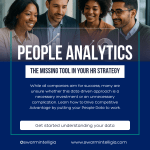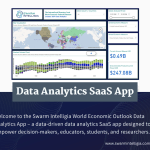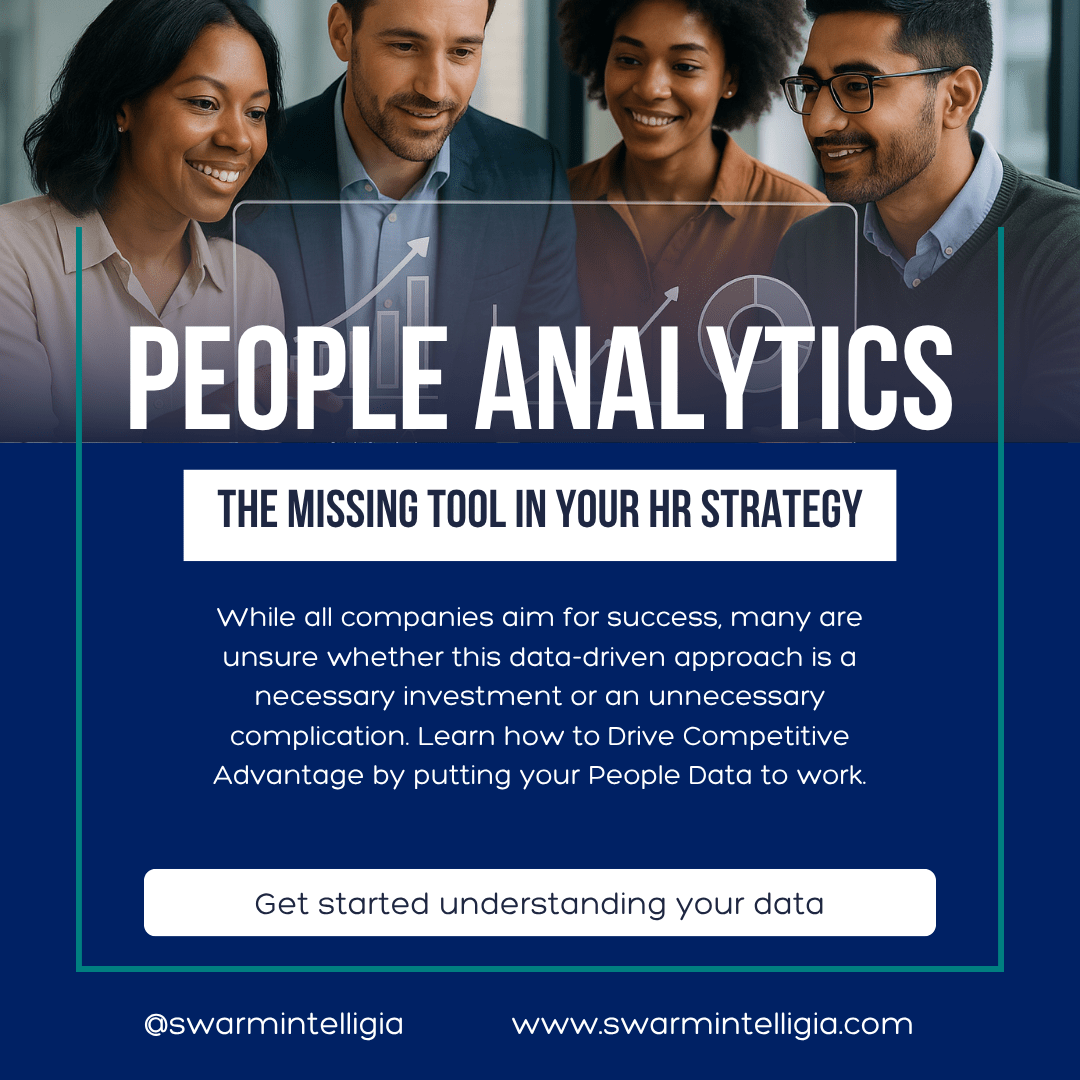Table of Contents
In an era where data is heralded as the new oil, organizations increasingly realize that their most valuable asset remains their people. But, how can organizations truly understand, empower, and optimize their human resources for sustained competitive advantage? The answer lies in People Analytics (PA) – a rapidly evolving field that, when approached holistically, integrates insights from diverse disciplines including Human Resources (“HR”), Business Strategy, Data Analytics, Organization Development, Psychology, and Law, to achieve sustained competitive advantage.
The strategic deployment of resources and capabilities is fundamental to an organization’s success. Yet, there is considerable uncertainty regarding the role of People Analytics, specifically its value proposition and suitability for individual organizational contexts. An organisation’s resources and capabilities include financial resources, physical resources, individual/human resources, and other organizational resources. The resources and capabilities controlled by an organization can create a competitive advantage, as explained in the Resource-Based View (Barney & Hesterly, 2012). Accordingly, an organisation’s internal strengths are key; the people in an organisation are the most difficult resource for competitors to copy. The unique skills, culture, and teamwork within an organization can give companies their long-term winning edge (sustained competitive advantage). However, this only occurs when organizations leverage excellent systems for managing, developing, and understanding their workforce. People Analytics is that bridge to the workforce; it is the engine that transforms raw people data, from operational metrics to employee sentiment, into actionable strategies. If organizations fail to manage, protect, and maximize the value of their people data, they will not be able to realize the full potential of their people.
In this article, we first define People Analytics and its influence on an organization’s strategy to achieve competitive advantage. Secondly, we review the interdisciplinary approach to People Analytics. Thirdly, we consider a use case for People Analytics. Next, we consider the challenges and solutions organizations may face in implementing People Analytics. Finally, we discuss the process of implementing People Analytics into an organization. Every person in an organization is essential to the overall success of the organization; as such, it is important to better understand the factors impacting people.
Analytics is a process of examining data using mathematical methods (Gillis, n.d.). People Analytics, which incorporates analytics developed with the advancement of statistical methods, computing power, and artificial intelligence, allowing for the collection and automation of large datasets (Anderson, Bjarnadóttir, & Ross, 2022). At its core, therefore, People Analytics is “an analytics tool used to understand people and organization data,” employing mathematical methods, statistical analysis, and increasingly, artificial intelligence (AI) to automate the collection and examination of large datasets.
People Analytics represents an evolution from reactive HR reporting to proactive, predictive, and prescriptive insights, moving beyond simple HR metrics to encompass broader organizational data. Every organization produces data, including operational, customer, and people data. People Analytics, therefore, analyses collected HR data applying mathematical, statistical, and computational intelligence methods to solve business problems.
HR data includes all the information an organization collects about its candidates, employees, and third parties which include name, age, gender, employment start and end dates, position title, compensation, employment history/tenure, experience, qualifications, employee performance, attendance, medical data, disciplinary actions, job-specific data like quotas, tickets opened and closed, and organization data such as operational and financial data. The data is generally stored in HR Tools such as Human Resources Information System (HRIS), Human Capital Management Systems (HCMS), Talent Management Systems (TMS), Applicant Tracking Systems (ATS), Payroll systems, and across the organization’s business systems, including finance, CRM, and individual departments.
People Analytics, therefore, is the difference between guessing and making fact-based decisions. Moreover, People Analytics has many advantages, which include:
- Strategic Decision-Making: People Analytics provides evidence-based insights to diagnose past events, predict future trends (like attrition or high performance), and prescribe interventions.
- Enhanced Employee Experience: Understanding employee needs, pain points, and drivers of engagement leads to better work environments and higher retention.
- Optimized Performance: Connecting people data (workforce planning, productivity, L&D) with business data enables leaders to make informed decisions that boost overall performance.
- Competitive Edge: If organizations fail to manage, protect, and maximize the value of their data, they will not be able to realize the full potential of their people.
Understanding the definition of People Analytics is the starting point to recognizing that People Analytics, like most business processes and systems, requires an interdisciplinary approach to succeed. No one person has all the answers, but the collective intelligence of interdisciplinary teams creates unlimited opportunities and potential.
Effective People Analytics is not the sole domain of HR or data scientists; it thrives on a collaborative, interdisciplinary approach.
Human Resources (HR): The Foundation
HR provides the core people data – recruitment, performance, compensation, training, diversity, and attrition. People Analytics empowers HR to move from an administrative function to a strategic partner, using data to design effective talent acquisition strategies, optimize onboarding, identify skill gaps, predict turnover, and create equitable reward systems.
Business Strategy & Management: The Guiding Compass
People Analytics initiatives must be intrinsically linked to overarching business goals. Business leaders provide the strategic context, ensuring that analytics efforts are focused on solving critical business problems and driving desired outcomes, for example, increased revenue, improved productivity, or enhanced innovation.
Data Analytics & AI: The Engine
This is where the “analytics” in People Analytics comes to life. Data Analysts, Business Intelligence Analysts, and Data Scientists employ methodologies like CRISP-DM (Cross-Industry Standard Process Model for Data Mining – Business Understanding, Data Understanding, Data Preparation, Modelling, Evaluation, and Deployment) to transform massive datasets into strategic insights and strategy prescriptions. The rise of AI and Machine Learning offers unprecedented capabilities for predictive modelling, natural language processing (for sentiment analysis from employee feedback), and identifying complex patterns that humans might miss. However, many organizations stop at creating reports describing past events (‘Descriptive Analytics’) instead of analysing why did past events occur (‘Diagnostic Analytics’), making predictions as to what might occur in the future (‘Predictive Analytics’), developing a set of policy and strategy prescriptions based on our understanding of what has occurred, why it has occurred, and what is expected to occur in the future (‘Prescriptive Analytics’), and applying computational intelligence methods to assist in making sense of vast amounts of structured, semi-structured, and unstructured data (‘Cognitive Analytics’).
Organization Development (OD): The Catalyst for Change
Insights from People Analytics often necessitate organizational change – be it in processes, culture, or leadership behaviours. OD practitioners are crucial for managing this change effectively. They leverage People Analytics findings to inform interventions related to team effectiveness, leadership development, organizational design, and fostering a data-driven culture.
Psychology: Understanding the “Why?”
While data analytics can show what is happening, psychology helps understand why. Principles from industrial-organizational psychology, behavioural economics, and social psychology can inform the questions asked, the interpretation of results, and the design of interventions. Understanding motivation, bias (conscious and unconscious), team dynamics, and individual differences is key to ensuring that People Analytics initiatives are both effective and ethical. For example, understanding psychological safety is crucial when interpreting data on team performance or innovation.
Law, Privacy & Data Governance: The Ethical & Legal Guardrails
Ethical and Responsible practices such as Data Privacy, Data Security, and Data Governance have become increasingly critical components of Data Analytics and AI frameworks, especially with the proliferation of Artificial Intelligence (AI). Organizations collect vast amounts of sensitive employee data, spanning performance, medical records, and demographics, making legal experts in privacy and data governance essential for any organization.
- Compliance: Navigating complex regulations like the General Data Protection Regulations (GDPR), local and regional Data Protection Acts, and emerging AI-specific laws (e.g., EU AI Act) is paramount. This includes ensuring a lawful basis for data processing, data minimization, purpose limitation, and data security.
- Ethical AI: AI in People Analytics can perpetuate biases present in their training datasets, leading to discriminatory outcomes in hiring, promotions, or performance evaluations. Legal and ethical oversight is needed to develop fairness-aware algorithms, conduct bias audits, and ensure transparency and explainability (XAI). As a starting point, however, organizations can begin with a commitment to pursuing Ethical and Responsible AI.
- Data Subject Rights: Employees have rights regarding their data (access, rectification, erasure). People Analytics systems must be designed to respect these rights.
- Data Security: Breaches of sensitive employee data can have severe legal, financial, and reputational consequences for SMEs and large organizations alike; therefore, investing in data security and data compliance is necessary throughout the data management life cycle.
- Accountability: Establishing who is accountable when AI-driven People Analytics tools make errors or cause harm is a significant legal challenge.
Now that we understand the connection between the disciplines of HR, Business Strategy, Data Analytics, Organization Development, Psychology, and Law and their relationship to the advancement of People Analytics within an organization, we next examine a use case for People Analytics within an organization.
People Analytics Use Case
There are numerous applications for People Analytics within an organization to help an organization achieve its strategic objectives and competitive advantage. We examine one example – Voluntary Turnover, which can have significant financial and non-financial costs to an organization and is a major driver of organizational health.
Case 1 – Voluntary Turnover
Objective
In the case of an organization focused on identifying key drivers of voluntary turnover among high-potential and critical-role employees, it should be able to predict attrition risk to help inform targeted retention strategies and succession planning interventions.
The Data Sources (HR & Other Business Systems)
- HRIS Data: Demographics, tenure, job history, role criticality, performance ratings, compensation & benefits data, training records, and promotion history.
- Exit Interview Data: Systematically collected and coded reasons for leaving.
- Employee Engagement surveys: Quantitative scores and qualitative comments (focusing on drivers like leadership, career development, work-life balance, recognition).
- Learning Management System (LMS) Data: Participation in development programs and skills acquisition.
- Project Management Data (anonymized): Correlation of project stress/workload with team turnover.
- External Market Data: Salary benchmarks for key roles locally, regionally, and internationally.
Analytical Approach (Data Analytics)
- Descriptive Analytics: Looks at what are the current turnover rates by department, role, tenure, and performance level to determine who is leaving.
- Diagnostic Analytics: Why are employees leaving? Correlate exit interview data, engagement scores, and other variables with turnover (e.g., “Are employees with lower engagement scores and limited career development opportunities more likely to leave?” What else is going on?
- Predictive Analytics: Develop an attrition risk model to identify employees at high risk of leaving in the next 6-12 months. Factors might include engagement, lack of recent promotion, pay significantly below market, manager relationships, and specific skill sets in high demand.
- Prescriptive Analytics (leading to OD interventions): What interventions are most likely to retain at-risk employees or specific segments? (e.g., ‘Offering targeted leadership development for managers of high turnover teams, career growth and advancement opportunities, and work environment/culture change).
Expected Outcomes & ROI
Organizations implementing People Analytics initiatives can expect to achieve the following outcomes and ROI:
- Reduced voluntary turnover in critical roles.
- Strengthen leadership pipeline with a higher “ready-now” successor rate.
- Significant cost savings associated with lower recruitment, onboarding, and training expenses for replacements.
- Improved employee morale and engagement as employees see the company investing in understanding and addressing their needs.
- Enhanced operational continuity and project success due to stable, skilled teams.
- Better strategic workforce planning informed by predictive insights.
- Companies can be positioned as an employer of choice.
Organizations seeking to implement People Analytics initiatives must simultaneously be aware of the challenges and solutions to implementing People Analytics.
Primary Challenges Associated with Implementing People Analytics
The primary challenges organizations face when implementing People Analytics include Data and Technology challenges, People and Skillset Challenges, Leadership and Strategic Challenges, and Ethical and Legal Challenges. Overcoming these challenges requires a deliberate, strategic, and phased approach that prioritizes clear business objectives, strong ethical governance, and a significant investment in both technology and people skills. By systematically anticipating and addressing these challenges, an organization can transform the implementation of People Analytics from a risky venture into a powerful, sustainable source of competitive advantage. We will explore these challenges and solutions further in a future article.
Getting Started and Sustaining Momentum with People Analytics
Collecting data is the starting point, but the data in and of itself has very little value until questions are asked of it. Organizations will be at different stages on the data analytics journey, but what is important is what companies do next: continue with business as usual or decide to innovate and transform. When organizations start by asking the right questions, the data tells a story that is understood through the process of describing, predicting, and prescribing.
Deloitte conducted research that showed that 74 percent of organizations frequently gather data, while 49 percent often perform prescriptive activities to gain insights, whereas 81 percent of organizations spend time producing reports frequently, yet only 21 percent do the same for building models (Kubicek, 2022). The value of People Analytics comes from what the organization does with the data to create value for the organization.
When an organization is ready to implement People Analytics, the following steps will help guide them through the process:
- Develop a People Analytics Strategy: Human Resources should take the lead by aligning business strategic objectives.
- Senior Executive Sponsorship & Stakeholder Buy-In: A senior leader is necessary to champion the initiative. In addition, key stakeholders should include Human Resources, Information Technology, Finance, Data Management, and business units in a cross-functional team.
- Identify sources of data and gaps: The Human Resources function, together with the Information Technology Department, or the Data Management function, should work together to identify all data sources.
- Investing in technology to manage data: The Human Resources function should work together with the Information Technology function to identify and implement the new technology.
- Upskilling and training: The Human Resources team should take the lead in identifying and implementing the required training for all identified users of the new technology.
- Data Audit & Data Quality: The cross-functional team should be tasked with identifying existing data sources (HRIS, ATS, LMS, Excel, engagement surveys, performance data, payroll, etc.). Assessing data quality, accuracy, completeness, consistency, and the interpretation of insights generated from the data is the primary responsibility of the data management team, with subject matter support from the HR team.
- Establish Ethical Guidelines & Data Governance: Human Resources, Legal (if available), Information Technology, and Data Management functions should be tasked with developing clear policies around data privacy, security, anonymity, consent, and the ethical use of employee data, in addition to ensuring compliance with relevant data protection laws (e.g., GDPR and local regulations).
To build data-driven organizations, executive leadership and senior management teams need to commit to developing a data-driven culture. A data-driven culture will encourage teams within the organization to prioritize data and facts instead of relying solely on gut instinct, experience, and anecdotal information (Kubicek, 2022). A data-driven culture encourages people to become critical thinkers who ask questions rather than jump to unsubstantiated conclusions.
Data Democratization is also important to create transparency and to bring an end to the practice of data silos. Data Democratization enables organizations to advance data usage across the enterprise and at different levels rather than in discrete sections (Enderes & Shannon, 2019). Furthermore, throughout this process, continuous communication, change management, and a focus on delivering tangible business value are paramount. It’s a journey, not a one-time project.
The process of introducing any change into an organization cannot and should not be understated; as such, the introduction of People Analytics into an organization will not only impact the people and business performance in isolation, but rather the entire organization. Getting the organization ready for the introduction of analytics and preparing it to use analytics is important. Organization Development approaches will be critical in addressing the changes that are needed.
Conclusion: The Future is Integrated
The journey through People Analytics leads to a clear and powerful conclusion: it is no longer a question of whether organizations should invest, but how and when. People Analytics is more than a trend; it’s a fundamental shift in how organizations understand and manage their workforce. The Resource-Based View established that an organisation’s people are its competitive advantage. However, without a system to understand and amplify this resource, its potential remains largely theoretical.
People Analytics is the strategic nervous system that connects raw data to human experience, transforming intuition into insight and insight into impactful action. Its true power is unlocked not by a single department or skill set, but by the synergistic collaboration of HR, business leaders, data scientists, OD professionals, psychologists, and legal and privacy experts to build depth and breadth. As AI and other technologies continue to advance, the need for this interdisciplinary approach, particularly with strong legal and ethical governance, will only intensify. Organizations that embrace this holistic view will be best positioned to not only “make a difference” but to thrive in the future of work.
By integrating diverse disciplines, we transform abstract data into a deep understanding of our workforce. Ultimately, to ignore People Analytics is to willingly neglect our most valuable, competitive advantage. In an era demanding unprecedented agility and innovation, it is the compass that guides organizations not just to survive, but to thrive. It proves that the best way to understand the business is to truly understand its people. We move from guessing to knowing, from reacting to strategically planning. So, is People Analytics right for your organization? If you are a leader committed to making strategic talent decisions, fostering an unbeatable culture, and driving tangible business results, the answer is an unequivocal yes. It is the bridge from knowing your people are valuable to proving it with data and acting on it with intelligence. The time to start building that bridge is now.
(n.d.). Retrieved from Cambridge Dictionary: https://dictionary.cambridge.org/dictionary/english/analytics
Anderson, D., Bjarnadóttir, M. V., & Ross, D. G. (2022, January 27). Using People Analytics to Build an Equitable Workplace. Retrieved from Harvard Business Review: https://hbr.org/2022/01/using-people-analytics-to-build-an-equitable-workplace
Barney, J. B., & Hesterly, W. S. (2012). Strategic Management and Competitive Advantage. New Jersey: Pearson Education, Inc.
CIPD. (2018, June 13). People analytics: Driving business performance with people data. Retrieved from CIPD: https://www.cipd.org/en/knowledge/reports/people-data-driving-performance/#:~:text=We%20found%20that%20people%20analytics,those%20in%20weak%20analytics%20cultures
CIPD. (2024, 02 29). People Analytics – understanding what people analytics is, why it’s important and how it’s used. Retrieved from CIPD: https://www.cipd.org/en/knowledge/factsheets/analytics-factsheet/
Development, T. C. (Director). (2021). VIVID: Leading with data to improve workforce wellbeing [Motion Picture].
Enderes, K., & Shannon, M. (2019, June 27). People Analytics Solutions: Market. Retrieved from Deloitte: https://www2.deloitte.com/content/dam/Deloitte/us/Documents/human-capital/us-human-capital-bersin-lt-people-analytics-solutions-market-primer.pdf
Furr, A. (n.d.). People Analytics 101 – What is People Analytics and How do I get started? Retrieved from Visier: https://www.visier.com/blog/what-is-people-analytics-and-how-do-i-get-started/
Gillis, A. S. (n.d.). People Analytics – HR Analytics. Retrieved from TechTarget: https://www.techtarget.com/searchhrsoftware/definition/human-resources-analytics-talent-analytics
Jenkins, A. (2022, 8 3). Business Performance Management (BPM) Defined. Retrieved from Oracle Netsuite: https://www.netsuite.com/portal/resource/articles/erp/business-performance.shtml
Kiron, D., Prentice, P. K., & Ferguson, R. B. (2014, May 12). The Analytics Mandate. Retrieved from MIT Sloan Management Review: https://sloanreview.mit.edu/projects/analytics-mandate/
Kranzen, M. (2024, August 02). Agile Change Management: Valuable Insights for Project Adaptability. Retrieved from Prosci: https://www.prosci.com/blog/agile-change-management
Kubicek, K. (2022, May 31). How To Use People Analytics To Drive Business Performance. Retrieved from Forbes: https://www.forbes.com/councils/forbeshumanresourcescouncil/2022/05/31/how-to-use-people-analytics-to-drive-business-performance/
O’Brien, K., & Downie, A. (2024, 06 27). What is people analytics? Retrieved from IBM: https://www.ibm.com/think/topics/people-analytics
Patil, D. (2011). Building Data Science Teams. In D. Patil, Building Data Science Teams (pp. 1-18). Sebastopol: O’ Reilly Media, Inc.
People Analytics An Essential Guide for HR. (n.d.). Retrieved from Academy to Innovate HR: https://www.aihr.com/blog/people-analytics/
PWC Middle East. (n.d.). Retrieved from Five Key considerations that can help make your People Analytics journey more successful.: https://www.pwc.com/m1/en/blog/five-key-considerations-help-make-your-people-analytics-journey-more-successful.html
Robertson, D. A., & Caldart, A. A. (2009). The Dynamics of Strategy. New York: Oxford University Press Inc.
Roxanne Paul is an experienced Strategic Human Resources and Organization Development Professional with deep expertise in architecting and executing impactful strategies across talent management, organizational effectiveness, and Governance, Risk & Compliance (GRC). She brings a multidimensional perspective to solving complex business challenges.
Her career has been focused on driving measurable business outcomes and elevating organizational performance within the service, energy, and construction industries. She understands the unique operational risks, regulatory pressures, and talent requirements inherent in these sectors.
Her approach is built on a synergy of disciplines:
- Law: Provides a robust framework for corporate governance, risk mitigation, employment law, and building defensible, ethical compliance programs.
- HR: Informs talent management lifecycle, succession planning, leadership development, and total rewards systems that attract and retain top-tier talent.
- Organization Development (OD): Enables the design of effective organizational structures, the management of large-scale change, and the cultivation of cultures defined by integrity, safety, and high performance.
She is passionate about partnering with organizations to build resilient organizations where talent thrives, risk is managed intelligently, and compliance is woven into the cultural fabric.





